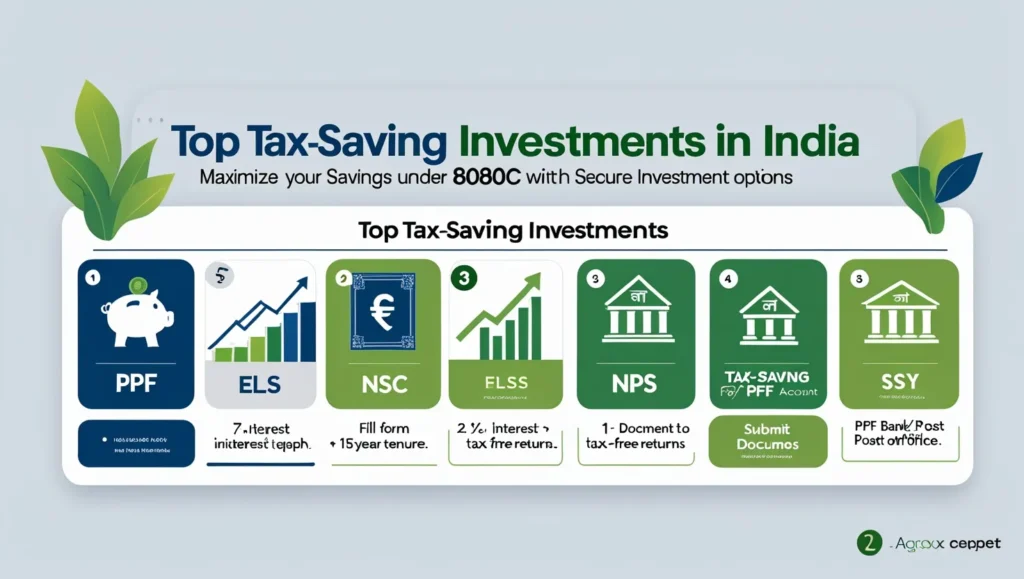Top Tax-Saving Investments in India are a crucial part of financial planning in India, helping individuals reduce taxable income while building wealth. Under Sections 80C, 80CCD(1B), and other provisions, taxpayers can claim deductions up to ₹1.5 lakh annually. This article explores the top tax-saving instruments and provides a detailed guide on opening a PPF account.
Popular Top Tax-Saving Investments in India Under Section 80C
1. Public Provident Fund (PPF)
-
Tenure: 15 years (extendable in blocks of 5 years).
-
Interest Rate: 7.1% (Q4 2023).
-
Tax Benefits: EEE (Exempt-Exempt-Exempt) status—contributions, interest, and maturity are tax-free.
-
Investment Range: ₹500 to ₹1.5 lakh annually.
2. Equity-Linked Savings Scheme (ELSS)
-
Lock-in Period: 3 years (shortest among 80C options).
-
Returns: Market-linked, averaging 12–15% historically.
-
Risk: High due to equity exposure.
3. National Savings Certificate (NSC)
-
Tenure: 5 years.
-
Interest Rate: 7.7% (compounded annually).
-
Taxation: Interest is taxable but reinvested.
4. National Pension System (NPS)
-
Additional Deduction: ₹50,000 under Section 80CCD(1B).
-
Returns: Market-linked with options in equity, debt, and government bonds.
-
Withdrawal: 60% tax-free at maturity; 40% used to buy annuities.
5. Tax-Saving Fixed Deposits (FDs)
-
Lock-in Period: 5 years.
-
Interest Rate: 6–7% (varies by bank).
-
Taxation: Interest is taxable.
6. Sukanya Samriddhi Yojana (SSY)
-
Purpose: Savings for a girl child’s education/marriage.
-
Interest Rate: 8.2% (Q4 2023).
-
Tenure: 21 years or until marriage post-18 years.
How to Open a PPF Account in India: A Step-by-Step Guide

Eligibility Criteria
Indian residents (minors can open via guardians).
NRIs are ineligible.
Required Documents
KYC documents (Aadhaar, PAN, passport-sized photos).
Address proof (utility bill, passport).
Nomination form (optional).
Steps to Open a PPF Account
Offline Method
Visit a Bank/Post Office: Head to an authorized branch (e.g., SBI, HDFC, India Post).
Fill Form 1: Provide personal details, nominee info, and deposit amount (min. ₹500).
Submit Documents: Attach self-attested KYC copies.
Initial Deposit: Pay via cash/cheque.
Receive Passbook: Issued immediately post-verification.
Online Method
Log in to Net Banking: Available for existing bank customers (e.g., SBI, ICICI).
Navigate to PPF Section: Under “Deposits” or “Investments.”
Enter Details: Nominee, investment amount, and tenure.
Complete KYC: Upload documents if not already verified.
Confirm and Pay: Use linked savings account.
Key Features of PPF
Partial Withdrawal: Allowed from the 7th year.
Loan Facility: Available between 3rd and 6th years.
Extension Options: Post-maturity, accounts can be extended indefinitely.
FAQs
Q1. Can I open multiple PPF accounts?
No, only one PPF account per individual is permitted.
Q2. What happens if I miss a yearly deposit?
A penalty of ₹50 applies for each default year, and the account becomes inactive.
Q3. Is PPF interest compounded annually?
Yes, interest is compounded yearly and credited on March 31.
Conclusion
Choosing the right tax-saving instrument depends on risk appetite, liquidity needs, and financial goals. PPF remains a favored choice for risk-averse investors due to its guaranteed returns and tax-free status. Combine PPF with equity options like ELSS for balanced growth. Always consult a financial advisor to align investments with your objectives.
Keywords: Tax-saving investments India, PPF account benefits, ELSS funds, Section 80C, Sukanya Samriddhi Yojana, NPS tax benefits, how to open PPF.